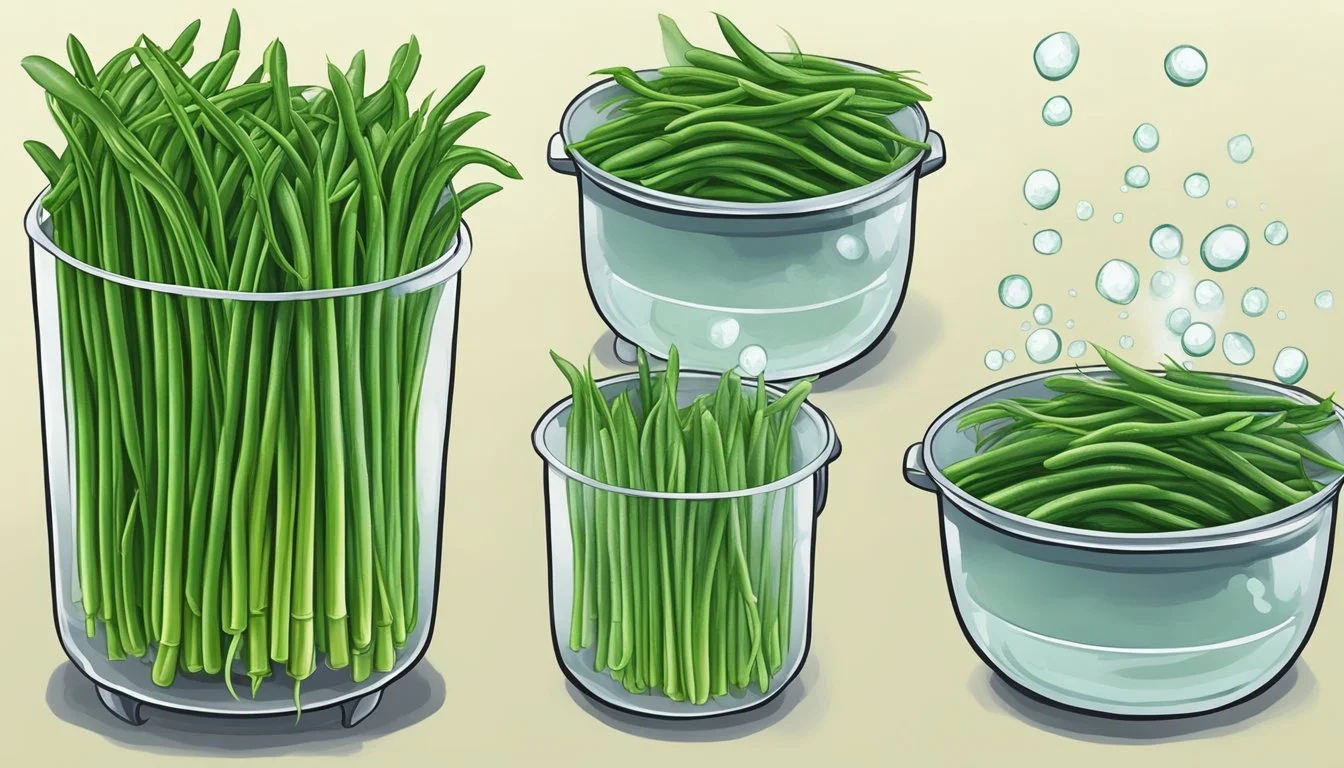Haricot Verts Substitutes
Top Alternatives for Green Beans
When it comes to culinary versatility, haricots verts are a favorite among many chefs and home cooks. These slender and tender French green beans add a delicate texture and nuanced flavor to a variety of dishes. If haricots verts are unavailable, regular green beans make an excellent substitute. They offer a similar taste profile, though they tend to be a bit thicker and shorter.
Another viable substitute for haricots verts is the Blue Lake green bean. Known for their robust nature, these beans hold up well under longer cooking times without losing their texture. This quality makes them ideal for recipes that require a sturdier bean.
For those looking for an alternative with a slight twist, wax beans provide a unique option. They share almost the same flavor as green beans but come in a vibrant yellow color, offering a visual appeal while maintaining the dish’s desired taste.
Understanding Haricot Verts
Haricot verts, also known as French green beans, are a popular ingredient in many cuisines due to their tender texture and refined flavor. This section covers their characteristics, nutritional profile, and culinary uses.
Characteristics of Haricot Verts
Haricot verts are slimmer and longer than regular green beans. Their tender texture and delicate flavor differentiate them from broader, coarser varieties. They are typically a vibrant green color and are harvested when young, ensuring they remain crisp. This variety is favored for its ability to cook quickly while maintaining a pleasant crunch.
Nutritional Profile
Haricot verts are low in calories but rich in nutrients, making them an excellent addition to a balanced diet. A serving typically contains about 31 calories, 2 grams of protein, and 3 grams of fiber. They are a good source of vitamin A, promoting vision and immune function, and vitamin C, which supports skin health and enhances iron absorption. They also provide essential minerals such as iron which is crucial for oxygen transport in the body. Notably, they are low in carbohydrates, saturated fat, and contain minimal sugars.
Culinary Uses
Haricot verts are versatile in the kitchen. They can be steamed, sautéed, roasted, or blanched without losing their tender texture and nuanced flavor. Commonly used in French cuisine, they pair well with ingredients like garlic, shallots, and butter. Additionally, they can be enjoyed in salads, where their crisp texture adds a refreshing element. Another popular method is to blanche them briefly before tossing them in a vinaigrette or incorporating into a stir-fry. They complement both meat and vegetarian dishes, making them a staple in various culinary traditions.
Selecting Substitutes
When selecting substitutes for haricot verts, consider the size, flavor, and texture of the alternative vegetables. Uniformity and tenderness are also key factors to ensure a comparable culinary experience.
Criteria for Substitution
Size and Shape: The substitute should closely match the slim and tender profile of haricot verts. Uniformity in size helps achieve consistent cooking times and texture.
Flavor and Texture: Aim for vegetables with mild, slightly sweet flavors and a crisp-tender texture when cooked. These characteristics align most closely with haricot verts and maintain the integrity of the dish.
Cooking Method: The vegetable should be suitable for similar cooking methods, such as steaming, boiling, or sautéing. Using a steamer basket can help retain the tender-crisp texture.
Best Vegetable Alternatives
Regular Green Beans: Often the closest match, they are slightly thicker but share a similar flavor and can be prepared in the same manner as haricot verts. They work well in steaming and sautéing.
Asparagus: Thin asparagus spears can substitute effectively due to their comparable texture and mild flavor. Use smaller, younger stalks to match the tenderness of haricot verts.
String Beans: These offer a similar crisp-tender profile when cooked and are usually easy to find in markets. Their texture and flavor make them a versatile substitute in various recipes.
When choosing an alternative, consider these key aspects to maintain the desired quality and taste of your dish.
Preparing Substitutes
When preparing substitutes for haricots verts, attention should be given to trimming and cleaning, selecting appropriate cooking methods, and proper seasoning and flavoring to get the best result for your dish.
Trimming and Cleaning
Start by thoroughly washing the green beans or other substitute vegetables under cold running water to remove any dirt or debris. Pat them dry with a clean towel.
Trim the ends of the beans with a sharp knife or scissors to remove the tough, fibrous parts. If using other vegetables like asparagus or snow peas, ensure they are similarly prepped to achieve consistent cooking.
Cooking Methods
Different cooking methods can be used depending on the substitute and the texture desired. Boiling water is effective for quick, tender results. Bring a large pot of salted water to a boil, add the prepared vegetables, and cook until just tender.
Steaming is another option that retains more nutrients. Use a steaming basket over boiling water, cover, and steam until the vegetables are tender-crisp.
For more flavor, sauté in a skillet with olive oil or butter. Sautéing can enhance the taste, especially when adding garlic or shallot. Microwaving is also an option: place the vegetables in a microwave-safe dish with a bit of water, cover with a microwave-safe lid, and heat until tender.
Seasoning and Flavoring
The right seasoning can make a significant difference. Start with basic seasonings like salt and freshly ground black pepper. To add complexity, incorporate herbs like fresh parsley, thyme, or chives.
For additional flavor, consider sautéing vegetables in olive oil or butter. Adding minced garlic or finely chopped shallot can bring a delightful aroma and taste.
A splash of lemon juice or some lemon wedges for serving can brighten the dish. Tossing the vegetables with a bit of extra virgin olive oil after cooking can enhance their richness. Adjust seasoning to taste before serving your substitute dish.
Incorporating Substitutes in Recipes
When substituting haricots verts in recipes, it's essential to choose similar vegetables that maintain the desired texture and flavor. Options like green beans, snap peas, and asparagus work well in various preparations.
Side Dish Recipes
Green beans are an excellent substitute in side dishes. Blanch them briefly, then sauté with olive oil, garlic, and a sprinkle of slivered almonds. Adding a touch of chopped parsley enhances the flavor. For a richer dish, toss with grated parmesan.
Snap peas can also be sautéed with butter and herbs for a fresh, crisp side. A lemon wedge squeeze adds brightness. These substitutes pair well with main courses like salmon or grilled chicken.
Main Courses and Pairings
In main course recipes, asparagus serves as a versatile substitute. It can be roasted with olive oil, salt, and pepper and paired with fish, like salmon, or chicken. Incorporating parmesan cheese and breadcrumbs creates a delightful crust.
Green beans work well in casseroles and stir-fries. They hold their texture and absorb flavors, making them ideal for hearty dishes. Pairing them with proteins such as beef or tofu enhances the meal's overall depth.
Salads and Cold Preparations
When preparing salads, snap peas offer a crisp, sweet alternative. Toss them with mixed greens, cherry tomatoes, and vinaigrette. Add a handful of slivered almonds for crunch. For a Mediterranean twist, include feta cheese and olives.
Green beans can be served cold in salads as well. Blanch them, then combine with red onion, cherry tomatoes, basil, and a light Dijon vinaigrette. This preparation keeps the beans crisp and flavorful, perfect for summer meals.
Preserving Flavor and Texture
Keeping the flavor and texture of your haricot verts substitutes intact requires careful handling during storage and reheating.
Storing Alternatives
Proper storage is vital in maintaining the crisp texture of haricot verts alternatives. Use an airtight container to ensure the vegetables stay fresh and robust. Airtight containers prevent moisture loss and contamination, which are crucial for food safety.
Freezing the vegetables is another effective option. Blanch them first to preserve color and nutrients, then store them in a tagged bag for easy identification. Refrigeration works well for short-term storage. Place the vegetables in a crisper drawer, as this environment maintains the optimal humidity levels necessary for keeping them fresh.
Reheating Techniques
When reheating substitutes for haricot verts, maintain their texture by using the right methods. Avoid microwaves that can make them soggy. Instead, use a skillet over medium heat, which helps retain a crisp texture. Add a small amount of olive oil or butter to enhance flavor.
Blanching is an additional reheating method. Briefly immerse the vegetables in boiling water, then transfer them to an ice bath. This technique revives the vegetables' original color and crispness. For a faster method, steaming can be effective too, as it preserves both flavor and texture without overcooking. Use a steamer basket over boiling water for a few minutes to achieve optimal results.
Shopping and Budget Considerations
When shopping for haricot verts substitutes, cost and availability are crucial aspects to ensure success. Utilizing savvy shopping tips can also make it easier to find quality ingredients without stretching your budget.
Evaluating Cost and Availability
Haricot verts tend to be more expensive due to their refined nature, often requiring higher prices at grocery stores. It is important to compare prices of potential substitutes like regular green beans, which are more budget-friendly.
Monitor seasonality, as prices fluctuate depending on the time of year. Out-of-season produce can be pricier. Buying produce from local markets often yields fresh and economical options.
Shopping Tips
When shopping, look at the product labels to ensure freshness and quality. Opt for locally grown beans to avoid higher costs that come with imported goods.
Tricks like purchasing in bulk can drive down prices. To maximize value, consider freezing excess produce.
Lastly, let store sales guide your purchases. Be vigilant about rotating deals, ensuring you get the best rates without compromising on quality.
Health and Dietary Concerns
When considering substitutes for haricot verts, it's essential to understand their health and dietary implications. Different substitutes can vary significantly in calories, carbohydrates, and potential allergens.
Low-Calorie and Low-Carb Options
Haricot verts are known for being low in calories and carbohydrates. When selecting substitutes, snap peas and zucchini emerge as excellent choices.
Snap peas: One cup (about 98g) provides approximately 41 calories, negligible fat, and about 7g of carbohydrates, including 2.5g of fiber. These vegetables also offer about 4g of protein and are rich in Vitamin C and Vitamin K.
Zucchini: A medium zucchini (about 196g) contains around 33 calories, less than 1g of fat, and about 7g of carbohydrates, including 2g of fiber. Zucchini is also a good source of potassium, with around 512mg per medium-sized vegetable.
These substitutes maintain low-calorie and low-carb profiles, making them suitable for weight-conscious or low-carb dietary plans. Their fiber and vitamin content also support overall health.
Allergies and Sensitivities
For individuals with allergies or food sensitivities, understanding the allergenic potential of substitutes is crucial.
Green beans (common): Generally considered a safe alternative, but some individuals might be sensitive or allergic to legumes. It's vital to monitor any allergic reactions when trying new substitutes.
Broccoli: It's low in calories and carbs and offers significant amounts of Vitamin C, Vitamin K, and potassium. While rare, broccoli can cause allergic reactions in some individuals, mostly due to its relation to other cruciferous vegetables.
Brussels sprouts: Another legume family member, Brussels sprouts are high in fiber and vitamins but may cause gastrointestinal discomfort in some people. Cooked Brussels sprouts can reduce the likelihood of experiencing any adverse reactions.
When dealing with allergies, double-check ingredient labels and consult with healthcare professionals to ensure the chosen substitute fits dietary restrictions and preferences.









